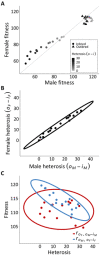Selection in males purges the mutation load on female fitness
- PMID: 34367659
- PMCID: PMC8327962
- DOI: 10.1002/evl3.239
Selection in males purges the mutation load on female fitness
Abstract
Theory predicts that the ability of selection and recombination to purge mutation load is enhanced if selection against deleterious genetic variants operates more strongly in males than females. However, direct empirical support for this tenet is limited, in part because traditional quantitative genetic approaches allow dominance and intermediate-frequency polymorphisms to obscure the effects of the many rare and partially recessive deleterious alleles that make up the main part of a population's mutation load. Here, we exposed the partially recessive genetic load of a population of Callosobruchus maculatus seed beetles via successive generations of inbreeding, and quantified its effects by measuring heterosis-the increase in fitness experienced when masking the effects of deleterious alleles by heterozygosity-in a fully factorial sex-specific diallel cross among 16 inbred strains. Competitive lifetime reproductive success (i.e., fitness) was measured in male and female outcrossed F1s as well as inbred parental "selfs," and we estimated the 4 × 4 male-female inbred-outbred genetic covariance matrix for fitness using Bayesian Markov chain Monte Carlo simulations of a custom-made general linear mixed effects model. We found that heterosis estimated independently in males and females was highly genetically correlated among strains, and that heterosis was strongly negatively genetically correlated to outbred male, but not female, fitness. This suggests that genetic variation for fitness in males, but not in females, reflects the amount of (partially) recessive deleterious alleles segregating at mutation-selection balance in this population. The population's mutation load therefore has greater potential to be purged via selection in males. These findings contribute to our understanding of the prevalence of sexual reproduction in nature and the maintenance of genetic variation in fitness-related traits.
Keywords: Diallel cross; fitness; good genes; heterosis; mutation load; sexual selection.
© 2021 The Authors. Evolution Letters published by Wiley Periodicals LLC on behalf of Society for the Study of Evolution (SSE) and European Society for Evolutionary Biology (ESEB).
Figures

References
-
- Agrawal, A. F. 2001. Sexual selection and the maintenance of sexual reproduction. Nature 411: 692–695. - PubMed
-
- Agrawal, A. F. , and Whitlock M. C. 2012. Mutation load: the fitness of individuals in populations where deleterious alleles are abundant. Annu Rev Ecol Evol Syst 43:115–135.
-
- Almbro, M. , and Simmons L. W. 2014. Sexual selection can remove an experimentally induced mutation load. Evolution 68:295–300. - PubMed
-
- Andersson, M. 1994. Sexual selection. Princeton Univ. Press, Princeton, NJ.

